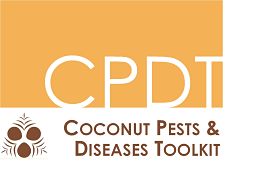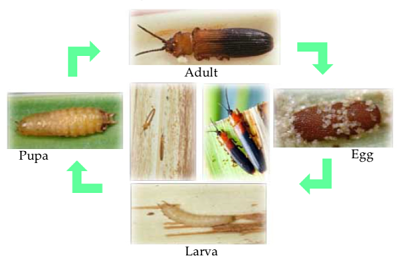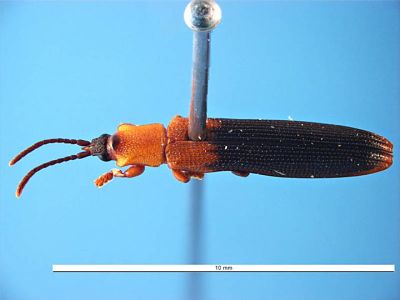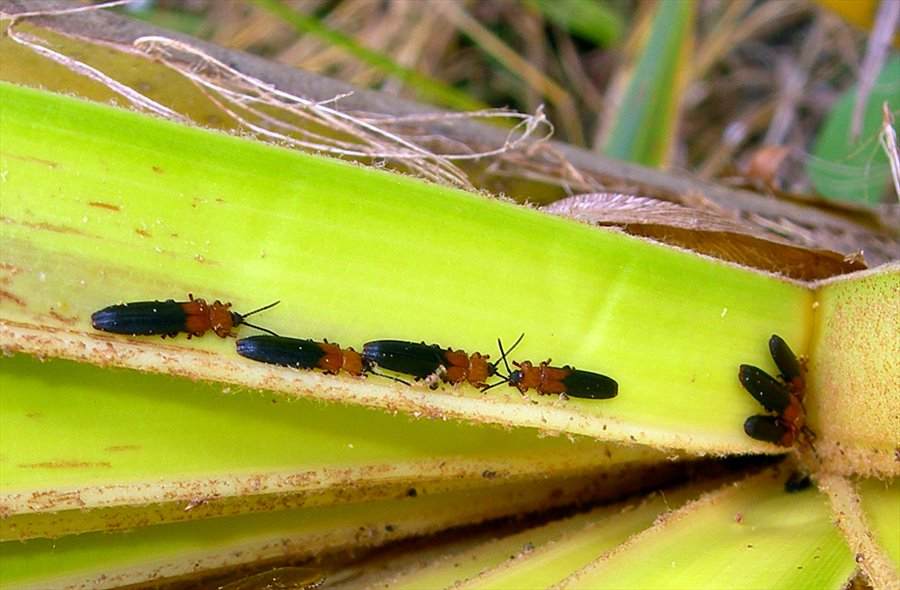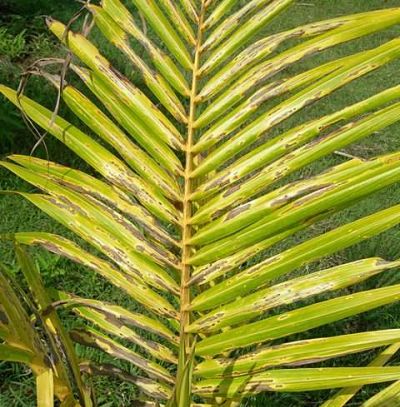Coconut hispine beetle - Brontispa
Coconut hispine beetle is a serious pest insect of coconut and other palms. There is a high risk of population outbreaks where it occurs.
Common nameCoconut hispine beetle |
Scientific nameBrontispa longissima |
on this page: Life-cycle and identification : Symptoms : Impacts : Distribution : Prevention : Controlling Coconut hispine beetle : Information sources and further reading
Life-cycle and identificationCoconut hispine beetles undergo complete metamorphosis. This means they go through distinct changes, with body forms that look very different. The four stages of the beetle life-cycle are egg, larva, pupa and adult. Often beetle eggs are difficult to find and their larvae are difficult to identify. Identification of adults is much easier. The coconut hispine beetle attack takes place between the unopened leaves of the central spear. |
Four distinct life stages of the coconut hispine beetle (© Dr. K.V. Sankaran, Kerala Forest Research Institute) |
Eggs
50-100 or more flat brown eggs (1.5 mm by 0.5 - 1 mm) are laid singularly or in groups of two to four, into chewed leaflet hollows that are covered and protected by faecal matter. The eggs hatch after 3-7 days.
Larvae
|
Larvae are creamy-white to yellow grubs that undergo 4-6 moults or instars (the exact number is not known with certainty) over an average of four weeks, before pupating. At the first instar, larvae are around the same length as the egg (1.5 mm) and can grow up to 2mm. They have a large head compared with the body and are white in colour. The second instar grub is slightly larger and more defined but more like the final instar. The final instar has a more segmented appearance, quite a flat yellow body and some evidence of adult looking features such as antennae and mandibles. The grub will reach a length of 8-10mm. The grubs avoid light and feed on leaflets of the unopened spear. PupaePupation lasts for 4-6 days before the adult beetle emerges. Pupae are a light yellow-brown colour and 9-10 mm long by 2 mm wide. They also have U-shaped hooks extending from the end of their body. AdultsAdults are 8-10 mm long and around 2 mm wide. The antennae are around 3 mm long. Males tend to be smaller than the females. The colour of both sexes is variable and differ from place to place. In general, the beetles backs are reddish-brown to black in colour, with a lighter brown head and antennae. |
Adult coconut hispine beetle(© Cameron Brumley, PaDIL)
Adult coconut hispine beetles on a leaflet within the spear leaf (© PestNet) |
The insect reaches full maturity two weeks after emerging from pupation, and the adults live for around 2 - 3 months.
Adults and larvae avoid light. Adults fly at night and feed on leaflets of the unopened spear.
Symptoms
Red-brown narrow decayed strips can be seen parallel to the midrib on the leaflets of the unopened spear. These decayed strips are caused by the grazing of adults and larvae.
The strips or streaks will become larger when the leaf unfolds and look blotchy and grey-brown. The leaves may even look burnt when symptoms are severe.
Severe damage can be seen on recently planted palms and seedlings in nurseries. However, all ages of palms are affected.
Varieties such as the Malayan Dwarf are reported to be more susceptible to hispine beetle damage compared with other varieties.
|
Leaflets showing decay caused by the feeding of the coconut hispine beetle (© PestNet) ImpactsPalms may die from severe attacks by the coconut hispine beetle or become increasingly vulnerable to disease, other pests and drought. |
Malayan Dwarf seedling with burnt-looking leaflet damage (© PestNet) |
The reduction in healthy palms and additionally the decrease in yield greatly effects coconut growing countries economically, socially and environmentally.
Many of the affected countries use coconut for cooking oils, food, building material and and large exports of coconut products.
Coastal areas which have poor soil tend to be reinforced with the planting of coconut palm, causing serious risks to the environment and coastal communities when palms are damaged or die.
Coconut plantations are also a major contributor to tourism in many of the affected countries.
Distribution
The coconut hispine beetle is widespread through Asia, Southeast Asia and Oceania. It is reported in American Samoa, Australia, French Polynesia, New Caledonia, Papua New Guinea, Samoa, Solomon Islands, Vanuatu, and Wallis & Futuna.
Please check with your local biosecurity / quarantine or SPC for up-to-date distribution information.
Prevention
Most importantly, the International Guidelines for transfer of coconut germplasm should be strictly followed to prevent pests and diseases being moved to new locations.
Other Brontispa species have been observed in Marshall Islands, Federated States of Micronesia, Northern Mariana Islands, Guam and Palau. Introduction of multiple Brontispa species to an area could increase the damage and make the beetles harder to control.
A lack of effective sampling methods and the difficulty in reaching the unopened spear leaf of the coconut palm may result in populations going unnoticed until symptoms become severe and obvious.
The rate of parasitism by natural predators may be low until the pest has reached high numbers (which is common to insects). By this stage adults may already have flown elsewhere to breed.
For general information on preventing pests and diseases of coconut, see the Prevention section of the website.
Controlling Coconut hispine beetle
We strongly recommend an integrated pest management (IPM) approach to the control of all insects, where possible. This is a combination of methods (pesticides, physical controls such as site hygiene, and biological controls) to minimise the use of pesticides and minimise the cost of control.
Integrated Pest Management (IPM)
The goal of IPM is to keep pest populations to a level below which they cause economic harm. IPM involves using multiple control options together for the economic control of pests (i.e. cultural, natural and chemical).
In an agricultural context the Food and Agriculture Organization defines IPM as "the careful consideration of all available pest control techniques and subsequent integration of appropriate measures that discourage the development of pest populations and keep pesticides and other interventions to levels that are economically justified and reduce or minimize risks to human health and the environment. IPM emphasizes the growth of a healthy crop with the least possible disruption to agro-ecosystems and encourages natural pest control mechanisms".
Cultural
Planting of more resistant varieties and avoiding the susceptible Rennell Tall and Malayan Dwarf hybrid may be beneficial where possible.
Samoa reported their green Dwarf variety to be resistant.
Solomon Islands tests reported that selected Ivory Coast and Fiji varieties were resistant. Additionally, Local Tall and Rennell coconut varieties seem to be more resistant than Federated Malay States and Red or Yellow Malayan Dwarf.
Natural
Natural parasites control the coconut hispine beetle well and are increasingly used.
Wasps that parasitise the larval stage have been introduced in to Solomon Islands (Russell Islands) then later Samoa. Tetrastichus brontispae was the first successful wasp to be introduced followed by Chrysonotomyia sp. (possibly native to the Solomons).
Other parasitoids of the egg stage have been released within some Pacific countries and include Haeckeliana brontispa Ferriere, Trichogrammatoidea nana Zehntner and Ooencyrtus sp.
The entomopathogenic (insect-killing) fungi Metarhizium anisopliae and Beauveria bassiana have also been promising in controlling the beetle. These fungi can be purchased in bulk online at websites such as alibaba.com.
The earwig Chelisoches morio has been seen feeding on the larvae.
However, outbreaks have needed additional parasites predators of the larval stage (which interrupts the beetle's life cycle). Asian beetle populations have been controlled by introducing the Asecodes hispinarum larval parasitoid from Samoa.
As predator and parasite populations can fluctuate and take some time to initially colonise, cultural methods should continue until the biological controls have established.
Chemical
Insecticides are not generally recommended due to costs and the difficulty in application to the grubs and adults that are hidden in between the unopened spear leaves.
However, to prevent outbreaks during dry seasons, insecticides may be required when initially planting young palms (especially susceptible varieties) or on nursery seedlings.
It is recommended to use products derived from plants where possible. A pyrethrum, chilli and soap combination or Derris (fish poison) has been successful. Synthetic pyrethroids have also been successful in the Solomon Islands.
Care should be taken when using insecticides as they may kill natural predators, be harmful to human and animal health and the environment.
Information sources and further reading
Asia-Pacific Forest Invasive Species Network (APFISN). 2008. Coconut Leaf Beetle. [ONLINE]
CABI. 2018. Brontispa longissima (coconut hispine beetle). [ONLINE]
FAO. 2004. Report of the expert consultation on coconut beetle outbreak in APPPC member countries. [ONLINE]
IUCN. 2009. Brontispa longissima. [ONLINE]
Nakamura, Konishi, Takasu. 2006. Invasion of the coconut hispine beetle, Brontispa longissima: current situation and control measures in Southeast Asia. In Proceedings of international workshop on development of database (APASD) for biological invasion (Vol. 3, pp. 1-9). Taichung, Taiwan: Taiwan Agricultural Chemicals and Toxic Substance Research Institute.
PestNet. 2017. Coconut hispine beetle. [ONLINE]
Plant Village. 2018. Coconut; Diseases and Pests, Description, Uses, Propagation. [ONLINE]
Winotai. 2013. IPM of Important Insect Pests of Coconut. FAO, pp. 1-60.
Yamashita, Takasu. 2010. Suitability of potential host plants in Japan for immature development of the coconut hispine beetle, Brontispa longissima (Gestro)(Coleoptera: Chrysomelidae). Japan Agricultural Research Quarterly: JARQ, 44(2), pp.143-149.
content reviewed by Bob Macfarlane, Solomon Islands, September 2018
